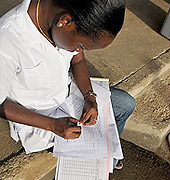AEFI surveillance components

This section describes the objectives of AEFI surveillance, which adverse events should be reported and by whom. Next we discuss how AEFI reports are generated, and how AEFI reports from health workers lead to investigation and action at the highest levels of responsibility in the National regulatory authority (NRA), the ministry of health and international organizations such as WHO and UNICEF. You will see an example of this reporting flow in action in the case study that follows Module 5.
The objectives for an effective AEFI surveillance system are to:
- Identify problems with vaccine lots or brands leading to vaccine reactions caused by the inherent properties of a vaccine,
- Detect, correct and prevent immunization errors caused by errors in vaccine preparation, handling, storage or administration,
- Prevent false blame arising from coincidental adverse events following immunization, which may have a known or unknown cause unrelated to the immunization,
- Reduce the incidence
 IncidenceThe number of new cases (e.g., of a disease, adverse event) occurring in a defined population during a given time interval, often one year. of injection reactions
IncidenceThe number of new cases (e.g., of a disease, adverse event) occurring in a defined population during a given time interval, often one year. of injection reactions Injection reactionAn AEFI classification that refers to an event resulting from anxiety about, or pain from, the act of injection rather than the vaccine. caused by anxiety or pain associated with immunization, by educating and reassuring vaccinees, parents/guardians and the general public about vaccine safety,
Injection reactionAn AEFI classification that refers to an event resulting from anxiety about, or pain from, the act of injection rather than the vaccine. caused by anxiety or pain associated with immunization, by educating and reassuring vaccinees, parents/guardians and the general public about vaccine safety, - Maintain confidence by properly responding to parent/community concerns, while increasing awareness (public and professional) about vaccine risks,
- Generate new hypotheses about vaccine reactions that are specific to the population of your country/region,
- Estimate rates of occurrence of AEFIs in the local population compared with trial and international data, particularly for new vaccines that are being introduced.
The following pages describe the following components of AEFI surveillance:
- Detection and reporting,
- Investigation,
- Causality assessment of AEFIs,
- Risk benefit assessment.
You will be introduced to the stakeholders involved in these processes, and their respective responsibilities.

